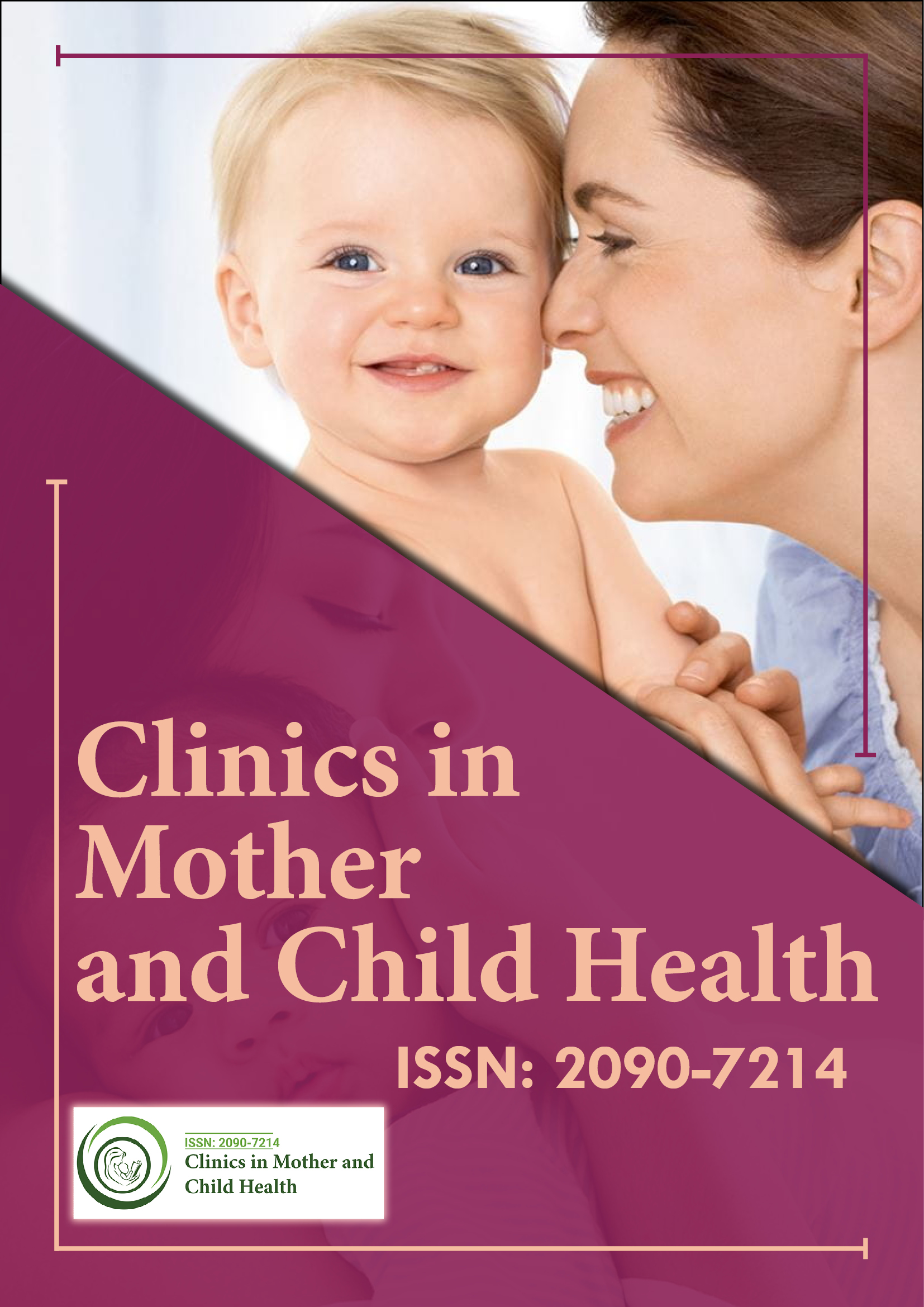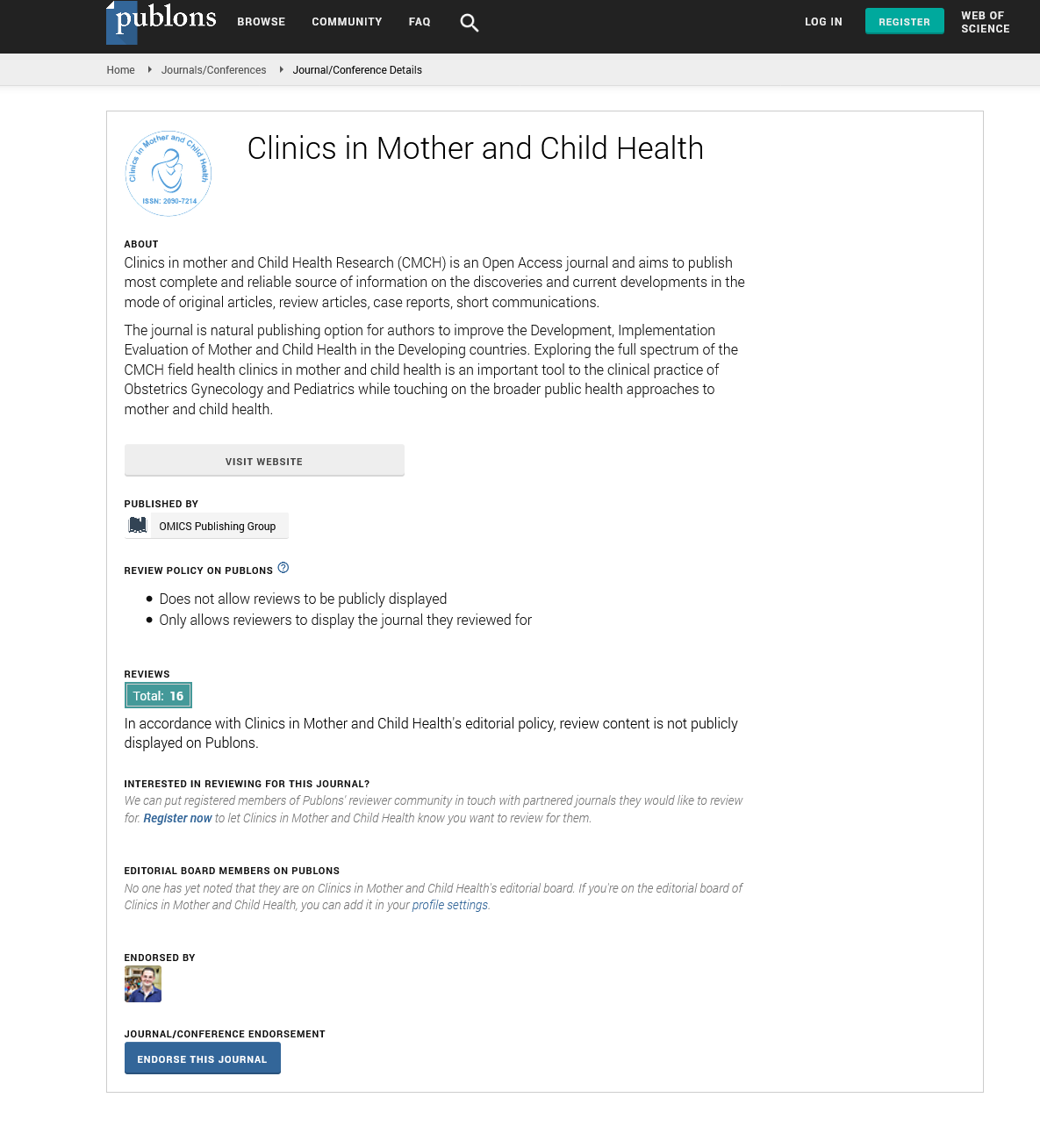Indexed In
- Genamics JournalSeek
- RefSeek
- Hamdard University
- EBSCO A-Z
- Publons
- Geneva Foundation for Medical Education and Research
- Euro Pub
- Google Scholar
Useful Links
Share This Page
Journal Flyer

Open Access Journals
- Agri and Aquaculture
- Biochemistry
- Bioinformatics & Systems Biology
- Business & Management
- Chemistry
- Clinical Sciences
- Engineering
- Food & Nutrition
- General Science
- Genetics & Molecular Biology
- Immunology & Microbiology
- Medical Sciences
- Neuroscience & Psychology
- Nursing & Health Care
- Pharmaceutical Sciences
Commentary - (2025) Volume 22, Issue 8
Enhancing Maternal and Infant Care Clinics in Rural China
Chen Wei-Ling*Received: 01-Aug-2025, Manuscript No. CMCH-25-30089; Editor assigned: 04-Aug-2025, Pre QC No. CMCH-25-30089; Reviewed: 16-Aug-2025, QC No. CMCH-25-30089; Revised: 21-Aug-2025, Manuscript No. CMCH-25-30089; Published: 28-Aug-2025, DOI: 10.35248/2090-7214.25.22.538
Description
In many rural regions of China, clinics focused on maternal and child health play an essential role in improving outcomes for mothers and infants. These clinics are often the first and sometimes only point of contact for prenatal screening, nutritional guidance, immunizations and postpartum follow-up. In such areas where hospitals may be geographically distant, these clinics help reduce travel burden and ensure continuity of care for pregnancies, births and early childhood. Staff members typically include midwives, community health nurses and pediatric generalists who are trained to monitor growth, detect complications and educate families on health practices including breastfeeding and hygiene. One challenge these clinics face is ensuring skilled staff retention. Remote locations often struggle to attract experienced professionals because of limited resources, lower pay and fewer opportunities for professional development. To counteract this, some local governments collaborate with provincial health departments to provide incentives, such as housing support, rural service allowances, or opportunities for training rotations at larger hospitals. By rotating staff periodically and creating mentorship links with tertiary care centers, smaller clinics gain access to technical guidance and continuous learning.
Another concern lies in supply and logistic constraints. Clinics may run short of essential supplies such as supplements, vaccines, or diagnostic kits. The disruptions in supply chains during seasonal weather can worsen this issue. To address it, collaborative between county health bureaus and non-governmental organizations arrange central procurement systems, buffer stock reserves and shared transport services that reach remote clinics on regular schedules. This planning helps prevent stock outs and ensures vaccines and other items reach even the most remote posts. Data management is critical for monitoring maternal and child indicators, but many clinics lack digital infrastructure. Use of paper records introduces delays and errors in tracking antenatal visits, immunization schedules and growth charts. To mitigate this, pilot programs deploy affordable tablet-based systems with linked servers at county centers. With training, clinic staff enter data during each visit; supervisors monitor trends remotely and send reminders when patients miss checkups. This system also supports research and resource allocation decisions.
Community engagement is another important element. Local health volunteers, village leaders and mothers’ groups are involved in promoting clinic attendance, educating women about danger signs in pregnancy and encouraging facility-based births. In communities where traditional beliefs may discourage early antenatal care, trusted community members help build trust and dispel myths. Outreach activities such as home visits during pregnancy by clinic staff help identify women who might otherwise not come in until late stages, thus allowing earlier detection of high-risk conditions. Outcome measures from several rural Chinese provinces show that maternal mortality, low birth weight and infant mortality rates decline when such clinics operate effectively. Regular antenatal checkups detect preeclampsia, gestational diabetes and fetal growth restriction earlier; prompt referrals to county hospitals prevent many adverse events. Immunization compliance is higher where vaccination services are offered consistently. Child growth monitoring allows nutritional interventions before malnutrition sets in.
Despite successes, some constraints linger. Cultural preferences for home births in parts of rural China resist change. Some women arrive late for their first antenatal visit, reducing the clinic’s capacity to fully intervene. Also, improving access to emergency obstetric care remains difficult when sink clinics lack transporting capacity or communication links. Addressing these requires strengthening referral networks and reliable transport such as ambulances or community transport funds. In summary, clinics serving mothers and children in rural China fulfill an indispensable role in health systems. Their success depends not only on clinical skills but also on logistics, data systems, community trust and referral linkage. With continuous government support, cross-level partnerships and community participation, such clinics can greatly improve maternal and child health outcomes in underserved regions of China.
Furthermore, integrating culturally sensitive practices such as incorporating local midwives into formal health teams or using local dialects during education sessions can deepen trust and expand access. Collaborating with traditional birth attendants, when properly trained and supervised, may also bridge gaps between modern medicine and rural customs. Emphasizing respectful maternity care and patient-centered communication ensures that women feel safe, heard and empowered throughout the prenatal and postnatal journey. To further strengthen the impact of rural maternal and child health clinics, integrating mental health support into routine care is becoming increasingly important. Pregnancy and early motherhood can be emotionally challenging, particularly in isolated or resource-limited settings. By training clinic staff to screen for postpartum depression and anxiety and providing referral pathways or basic counseling services, clinics can address a critical but often overlooked aspect of maternal health. Incorporating mental health education into group sessions and community outreach can also help reduce stigma and encourage more women to seek help. Holistic care that includes both physical and emotional well-being ultimately leads to better outcomes for mothers and children alike.
Citation: Wei L (2025). Enhancing Maternal and Infant Care Clinics in Rural China. 22:538.
Copyright: © 2025 Wei L. This is an open-access article distributed under the terms of the Creative Commons Attribution License, which permits unrestricted use, distribution and reproduction in any medium, provided the original author and source are credited.

